
102
HNUE JOURNAL OF SCIENCE
Social Sciences 2024, Volume 69, Issue 1, pp. 102-112
This paper is available online at http://stdb.hnue.edu.vn
DOI: 10.18173/2354-1067.2024-0011
“EACH”, “ONE” AND SYNTAX
STRUCTURES CONTAINING “EACH -
EACH/ONE” IN VIETNAMESE
SENTENCES
Dao Duy Tung* and Le Viet Doan
School of Social Sciences and Humanities,
Can Tho University, Can Tho city, Vietnam
*Corresponding author: ddtung@ctu.edu.vn
Received December 14, 2023.
Revised January 18, 2024.
Accepted February 12, 2024.
Abstract. The article discusses the different
perspectives and explanations for the classification
of “each” and “one” in the Vietnamese word class
system. According to these perspectives, “each”
and “one” can be classified as adjectives,
demonstratives, nouns, numerals, adverbs, or
functional words, and they can belong to either the
lexical word or functional word category. Some
authors have provided brief explanations of the
meaning of these two words, but the syntactic
structure of sentences containing “each-one/every”
has not been analyzed. Based on the analysis, the
article argues that “each” and “one” are both
quantifiers, and they belong to the functional word
category. In addition, “one” can additionally be
classified as a numeral and belong to the lexical
word category. The pair of coordinating
quantifiers “each - each/one” can be used together
to mark the boundary between the theme and rheme
of a sentence. In this case, “each” marks the theme,
and “each/one” marks the rheme of the same
grammatical level. Additionally, when used alone,
“each” or “every one” also marks the theme.
Keywords: each, one, syntactic structure, theme, rheme.
“MỖI”, “MỘT” VÀ CẤU TRÚC
CÚ PHÁP CHỨA “MỖI - MỖI/MỘT”
TRONG CÂU TIẾNG VIỆT
Đào Duy Tùng* và Lê Việt Đoàn
Khoa Khoa học Xã hội và Nhân văn,
Đại học Cần Thơ, Tp. Cần Thơ, Việt Nam
*Tác giả liên hệ: ddtung@ctu.edu.vn
Ngày nhận bài: 14/12/2023.
Ngày sửa bài: 18/1/2024.
Ngày nhận đăng: 12/2/2024.
Tóm tắt. Bài viết khái quát các quan điểm và lí
giải nguyên nhân xác định “mỗi”, “một” khác nhau
trong hệ thống từ loại tiếng Việt. Theo đó, các nhà
nghiên cứu quan niệm “mỗi”, “một” là tính từ, chỉ
định tự, danh từ, số từ, phụ từ, từ công cụ,… thuộc
thực từ hay hư từ. Hai từ này cũng mới chỉ được
một số tác giả giải thích sơ lược về mặt ý nghĩa.
Còn về mặt cú pháp, cấu trúc câu chứa “mỗi - mỗi/
một” chưa được phân tích. Bài viết quan niệm
“mỗi”, “một” cùng nhóm với “từng, mọi”,… là
lượng từ, thuộc hệ thống hư từ; còn “một” cùng
nhóm với “hai, ba, bốn”,… là lượng từ, thuộc hệ
thống thực từ. Cặp lượng từ “mỗi - mỗi/ một” hô
ứng với nhau có tác dụng đánh dấu biên giới đề -
thuyết các bậc. Trong đó, “mỗi” đánh dấu đề,
“mỗi/ một” đánh dấu thuyết cùng bậc quan hệ cú
pháp. Ngoài ra, khi được dùng đơn lẻ, “mỗi”, hay
“mỗi một” cũng đánh dấu đề.
Từ khóa: mỗi, một, cấu trúc cú pháp, đề, thuyết.
1. Mở đầu
Từ năm 1915, những giáo sĩ người Ý, Bồ Đào Nha, như Francisco Buzomi, Francisco de
Pina, Gaspar de Amaral, Antonio Barbosa, Cristoforo Borri, Alexandre de Rhodes (Đắc Lộ),…
đã tới Việt Nam truyền giáo. Trong quá trình truyền giáo, các giáo sĩ đã học và nghiên cứu tiếng
Việt, và năm 1951, Alexandre de Rhodes bắt đầu bàn về ngữ pháp tiếng Việt trong cuốn Từ điển

“Mỗi”, “một” và cấu trúc cú pháp chứa “mỗi - mỗi/một” trong câu tiếng Việt
103
Việt - Bồ - La (Dictionarium Annamiticum - Lusitanum - Latinum) [1]. Nhưng gần 200 năm sau,
với sự xuất hiện của công trình Ngữ pháp tiếng Việt của Taberd (1838) [2], sau đó là hai công
trình Grammaire Annamite (1864) của G. Aubaret [3] và Grammaire de la langue Annamite
(1883) của Trương Vĩnh Ký [4] thì ngữ pháp tiếng Việt mới thực sự được miêu tả chi tiết và bài
bản. Như vậy, có thể nói, ngữ pháp tiếng Việt bắt đầu được nghiên cứu khoảng từ năm 1651 cho
tới ngày nay. Gần 400 năm, những vấn đề về ngữ pháp tiếng Việt được nghiên cứu, làm rõ qua
nhiều khía cạnh, góc độ khác nhau, từ khái quát đến cụ thể.
Do quan niệm khác nhau về phạm trù từ vựng - ngữ pháp, về tiêu chuẩn phân định, các nhà
nghiên cứu đưa ra các ý kiến khác nhau về hệ thống từ loại, trong đó có xác định từ loại của
“mỗi”, “một”, có thể khái quát thành: (1) “mỗi”, “một” là tính từ chỉ số; (2) “mỗi”, “một” là
chỉ định tự hay số mục chỉ định tự; (3) “mỗi”, “một” là danh từ; (4) “mỗi”, “một” là số từ, lượng
từ hay số lượng từ; (5) “mỗi” là phụ từ, định từ, hay phó từ; “một” là số từ - “một” là định từ;
(6) “mỗi”, “một” là phụ từ, hư từ hay từ công cụ, từ ngữ pháp. Trong số đó, một số tác giả chỉ
giải thích sơ lược về mặt ý nghĩa của “mỗi”, “một”, mà chưa phân tích cấu trúc cú pháp câu chứa
“mỗi - mỗi/ một”. Do đó, trên cơ sở tổng thuật những quan điểm tiêu biểu về ngữ pháp, trong đó
có xác định từ loại của “mỗi”, “một” và cấu trúc cú pháp chứa “mỗi - mỗi/ một”, bài viết phân
tích, chỉ ra nguyên nhân của việc định vị “mỗi”, “một” khác nhau trong hệ thống từ loại tiếng
Việt, đặc biệt bài viết bước đầu phân tích một cách có hệ thống các mô hình cấu trúc cú pháp câu
chứa “mỗi - mỗi/ một”. Trong câu, khi được dùng phối hợp, “mỗi”, “mỗi một” đánh dấu đề,
“mỗi/ một”, “mỗi một” đánh dấu thuyết cùng bậc quan hệ cú pháp. Ngoài ra, khi được dùng đơn
lẻ, “mỗi”, hay “mỗi một” cũng có tác dụng đánh dấu đề.
2. Nội dung nghiên cứu
2.1. “Mỗi”, “một” trong hệ thống từ loại tiếng Việt
2.1.1. Định vị “mỗi”, “một” trong hệ thống từ loại tiếng Việt
Dưới đây là một số quan điểm tiêu biểu về việc định vị “mỗi”, “một” trong hệ thống từ loại
tiếng Việt.
2.1.1.1. “Mỗi”, “một” là tính từ chỉ số
Trong các sách ngữ pháp trước đây về tiếng Việt, các học giả xếp số từ vào tính từ, như
Trương Vĩnh Ký, Bu-sê, Bác-bi-ê, Bùi Đức Tịnh, Nguyễn Lân,…
Ở mục số của danh từ (nombre du substantif), Trương Vĩnh Ký (1883) đề cập đến tính từ chỉ
số (l’adjectif numéral) một. Theo tác giả, danh từ trong tiếng Việt không biến đổi hình thái. Trong
đó, danh từ số ít được xác định (chính xác) hoặc không xác định. Danh từ số ít xác định kết hợp
với mạo từ ở phía trước, chẳng hạn: Con chim bay (l’oiseau vole). Danh từ số ít không xác định,
nếu muốn rõ ràng hơn, chúng ta đặt trước nó tính từ chỉ số một (un), chẳng hạn: Một người có tội
(un homme coupable); Một cái cây (un arbre, une pièce de bois); Tôi mua một cây dù (j’achète
un parapluie),… [4; 78].
Theo Trương Vĩnh Ký, mỗi, mỗi một là tính từ chỉ số đứng trước danh từ, thuộc tính từ chỉ
số không xác định. Trong số các tính từ chỉ số không xác định và tính từ nghi vấn (adjectifs
indéfinis et interrogatifs), có một số tính từ luôn đứng trước và một số luôn đứng sau danh từ.
Trong đó, những từ đứng trước danh từ gồm: cả, cả và, cả thảy, hết, hết thảy, hết mọi, hết cả, đều,
mọi, mỗi (Mỗi giờ, à toute heure, chaque heure; mỗi người mỗi ưng, chacun consent, consenti à
l’unanimité; mỗi nước mỗi vua, un souverain à chacun des Etats, chaque royaume a son roi; mỗi
người mỗi ý, chacun son avis), mỗi một (Mỗi một năm, chaque année), hằng, trọn, trót, những,
các, mấy, bao nhiêu, chúc, chúng, chư, chung [4; 147-150].
Có thể thấy, quan niệm của Trương Vĩnh Ký (1883) về vị trí và khả năng kết hợp của “mỗi”,
“một”, “mỗi một” là rất sát hợp. Các công trình nghiên cứu về ngữ pháp tiếng Việt sau này đa
phần đều miêu tả theo hướng đó nhưng cách dùng thuật ngữ có khác.

DD Tùng* & LV Đoàn
104
2.1.1.2. “Mỗi”, “một” là chỉ định tự hay số mục chỉ định tự
Một số học giả xếp “mỗi”, “một” vào loại chỉ định tự, hay số mục chỉ định tự, như J. Coóc-
đi-ê, Trần Trọng Kim, Phạm Duy Khiêm, Bùi Kỷ,…
Ở chương VI, Trần Trọng Kim, Phạm Duy Khiêm, Bùi kỷ (1940) chia chỉ định tự thành: (1)
chỉ thị chỉ định tự, (2) số mục chỉ định tự, (3) nghi vấn chỉ định tự, (4) phiếm chỉ chỉ định tự [5;
49-60]. Trong đó, số mục chỉ định tự gồm: (1) lượng số chỉ định tự và (2) thứ tự chỉ định tự. Theo
đó, một nằm trong số đếm, thuộc lượng số chỉ định tự [5; 52]. Mỗi nằm trong phần phân phối,
cũng thuộc lượng số chỉ định tự. Các tác giả cho rằng: “Những tiếng lượng số chỉ định tự chỉ định
cái phần phân phối là: mỗi, từng, dùng đứng trước tiếng danh tự để chỉ từng đơn vị” [5; 54]. Các
tác giả giải thích thêm: “Tiếng lượng số chỉ định tự mỗi có thể dùng đứng trước tiếng danh tự làm
chủ từ hay túc từ:
Mỗi người làm một việc.
Nó cho mỗi người một đồng bạc [5; 54].
Tương tự Trần Trọng Kim, Phạm Duy Khiêm, Bùi kỷ, tác giả Bùi Đức Tịnh (1952) cũng cho
rằng “một” là số đếm, còn “mỗi” là lượng số chỉ định từ chỉ một lượng ít, chỉ đơn vị của một
toàn số. Cả hai thuộc số mục chỉ định từ [6; 61-62].
2.1.1.3. “Mỗi”, “một” là danh từ
G. Aubaret (1864) xếp “một” vào danh từ chỉ số (des noms de nombre) [3; 25-29].
Tương tự, các tác giả Ủy ban Khoa học Xã hội Việt Nam (1983) quan niệm một (hai, ba,
mười, một trăm,…), những, các, vài, mấy,… tất cả, số đông, phần lớn,… là danh từ chỉ số lượng
sự vật (danh từ số lượng) [7; 78]. Tuy G. Aubaret (1864) và các tác giả Ủy ban Khoa học Xã hội
Việt Nam (1983) không đề cập đến “mỗi”, nhưng theo cách trình bày hệ thống từ loại trong sách,
có thể hiểu “mỗi” cũng là danh từ chỉ số.
2.1.1.4. “Mỗi”, “một” là số từ, lượng từ hay số lượng từ
Một số học giả xếp “mỗi”, “một” vào từ loại số từ, lượng từ hay lượng số từ như: Nguyễn
Kim Thản, Trương Văn Chình - Nguyễn Hiến Lê, Nguyễn Tài Cẩn, Đái Xuân Ninh, Hồ Lê, Cao
Xuân Hạo, Nguyễn Vân Phổ,…
Nguyễn Kim Thản (1963) xếp “một” vào định số từ, còn “mỗi” (mọi, từng) vào lượng số
từ, cả hai đều thuộc số từ. Theo tác giả, “mỗi là từ mượn của tiếng Hán; nó còn có hình thức nữa
là mỗi một. Nó chỉ một đơn vị riêng lẻ trong một số lượng nhất định. Thường thường danh từ này
chỉ đơn vị tính toán (chỉ sự vật được phân phối), và sau đó còn có từ tổ số từ + danh từ… Song
hiện nay do ảnh hưởng của lối diễn đạt trong các ngôn ngữ Ấn Âu, nhiều khi mỗi được dùng với
nghĩa mọi, tất cả, các, và sau đó không có từ tổ số từ + danh từ nữa [8; 198].
Trương Văn Chình, Nguyễn Hiến Lê (1963) xác định “một”, “mỗi” là lượng từ nhất định,
thuộc tiểu loại lượng từ. Các tác giả quan niệm những tiếng dùng làm lượng từ, về từ tính là thể
từ. Theo đó, “một là số đầu trong số đếm, trỏ lượng nhất định lấy làm đơn vị. Ta cũng dùng mỗi.
Mỗi ngoài nghĩa là một, còn hàm thêm ý “như nhau”; tỉ dụ:
Mỗi bữa tôi ăn ba bát cơm.
Mỗi năm có bốn mùa.
tức là “bữa nào cũng như bữa nào, tôi đều ăn ba bát cơm cả”, “năm nào cũng như năm nào
đều có bốn mùa”.
Ta còn nói mỗi một:
Mỗi một bữa tôi ăn ba bát cơm.
Mỗi một năm có bốn mùa.
Có khi mỗi không dùng theo nghĩa nói trên, mà chỉ có ý nhấn mạnh:
Tôi ăn có mỗi một quả cam [9; 310-311].

“Mỗi”, “một” và cấu trúc cú pháp chứa “mỗi - mỗi/một” trong câu tiếng Việt
105
Cao Xuân Hạo, Nguyễn Vân Phổ cũng cho rằng “mỗi”, “một” là lượng từ. Theo Cao Xuân
Hạo, một (hai, ba, năm, bảy…) là lượng từ xác định (số từ); còn mỗi (những, các, mọi…) là lượng
từ không xác định [10; 100]. Nguyễn Vân Phổ cho rằng một là lượng từ chính xác (số từ) [10;
357], còn mỗi (những, các, mấy, mọi, từng) là lượng từ không chính xác [11; 368].
Hồ Lê (1992) gộp hai tiểu loại số từ và lượng từ thành số lượng từ. Theo tác giả, mỗi (những,
các, từng, cả) là lượng từ; còn một (hai, ba… vài, dăm ba, dăm bảy) là số từ [12; 144-149]. Còn
Đái Xuân Ninh (1978) quan niệm một (hai, ba, bốn…) là từ chỉ số (a2) [13; 89]; mỗi (từng, mọi,
những, các) là từ chỉ số lượng (a3) [13; 89, 112]. Tương tự các tác giả khác, Đái Xuân Ninh cho
rằng: “Những từ chỉ số lượng là những từ kèm đi theo danh từ [13; 112].
2.1.1.5. “Mỗi” là phụ từ, định từ, hay phó từ; “một” là số từ - “một” là định từ
Lê Văn Lý (1948, 1972) và hầu hết các tác giả sau thập niên 80 của thế kỷ XX đều cho rằng
“mỗi” là phụ từ (định từ), còn “một” là số từ. Các tác giả cũng phân biệt “một” là số từ (xác
định) và “một” là định từ (bất định).
Lê Văn Lý cho rằng “mỗi” là phụ tự khởi đầu, bên cạnh các phụ tự trung gian, phụ tự tận cùng
và phụ tự tự do, thuộc nhóm phụ tự, như: mỗi người; còn “một” thuộc từ loại số từ [14; 125].
Diệp Quang Ban (1989) xác định “một” là số từ, còn “mỗi” là phụ từ chuyên đi kèm danh
từ, được gọi là định từ (một tiểu loại của phụ từ). Theo tác giả, một (hai, ba, bốn…) là số từ số
đếm xác định, bên cạnh số đếm phỏng chừng như một vài, dăm ba, dăm bảy..., và số từ thứ tự
[15; 123]. Định từ chuyên đi kèm về phía trước danh từ và chỉ quan hệ về số lượng. Các định từ
thường gặp là các, những, một, mọi, mỗi, từng, mấy… [15; 141]. Ba từ những, một, các và dạng
zêrô làm thành một đối hệ và được gọi là các quán từ; các từ mọi, mỗi, từng có ý nghĩa phân phối
[15; 141].
Tương tự, Diệp Quang Ban - Hoàng Văn Thung [16; 107], Lê Biên [17; 140], Nguyễn Văn
Thành [18; 351], Nguyễn Văn Lộc - Nguyễn Mạnh Tiến [19; 43] cũng quan niệm “một” là số từ
xác định. Còn đối với “mỗi”, Diệp Quang Ban - Hoàng Văn Thung cho rằng “mỗi” cùng nhóm
với từng, mọi dùng kèm trước danh từ, chỉ ý nghĩa phân phối về số lượng (định từ) [16; 123]. Lê
Biên cho rằng “mỗi” (mọi, từng) là phụ từ biểu thị ý nghĩa phân lượng, phân phối [17; 149].
Nguyễn Văn Lộc, Nguyễn Mạnh Tiến xác định “mỗi” (từng, mọi, những, các) là phó từ đi kèm
danh từ [19; 143].
Các tác giả được đề cập ở trên cũng phân biệt “một” là số từ và “một” là định từ. Theo Diệp
Quang Ban - Hoàng Văn Thung, “một” cùng nhóm với những, các là định từ (một tiểu loại của
phụ từ) [16; 121-122]. Lê Biên cho rằng “một” và “những” còn được gọi là phụ từ phiếm định
(quán từ phiếm định) [17; 149]. Nguyễn Văn Thành cũng phân biệt “một” là số từ số lượng [18;
351] và “một” (con, cái, chiếc, những, các) là định từ [18; 363].
Đinh Văn Đức cũng cho rằng “một” (hai, mười, trăm, nghìn, vạn, triệu) là từ chỉ số đếm,
còn “mỗi” (mọi, từng) là từ có ý nghĩa phân phối [20; 85]. Những từ này xuất hiện ở vị trí -3 và
là thành tố phụ trước danh từ [20; 79]. Ngoài ra, theo tác giả, một (những, các) còn là hư từ chỉ
số, với ý nghĩa bất định [20; 86].
Trong các quan niệm, quan niệm (5) có nhiều sự đồng tình của các nhà nghiên cứu.
2.1.1.6. “Mỗi”, “một” là phụ từ, hư từ hay từ công cụ, từ ngữ pháp
Lê Cận, Phan Thiều (1983) quan niệm “mỗi”, “một” đều là phụ từ. Trong đó, “mỗi” (từng)
là phụ từ trước của danh từ chỉ ý nghĩa riêng lẻ [21; 154]; “một” cũng là phụ từ trước của danh
từ - phụ từ chỉ số lượng chính xác [21; 155].
Nguyễn Anh Quế (1988) cho rằng những các, mọi, mỗi, từng, cái là các hư từ nhóm A; cũng,
vẫn, đã, đang, không, chưa, chẳng, hãy, đừng, chớ, rất, hơi... là hư từ nhóm B. Nhóm A chuyên
làm thành tố phụ cho một đoản ngữ có danh từ làm trung tâm, nhóm B chuyên làm thành tố phụ
cho một đoản ngữ có động từ làm trung tâm [22; 68]. Các từ mỗi, một, từng thuộc tiểu loại A2.
Theo tác giả, “các hư từ này có nét nghĩa chung là đều biểu thị lượng số của danh từ trung tâm

DD Tùng* & LV Đoàn
106
như những, các, mọi. Song nếu như những, các, mọi chủ yếu là để nêu lên đặc trưng về số nhiều
của danh từ trung tâm, thì trái lại, mỗi, một, từng lại chủ yếu là biểu thị lượng số ít và do đó có
liên quan về ngữ nghĩa với một số từ” [22; 76].
Đỗ Thanh đồng nhất và gọi chung từ công cụ là từ hư, từ ngữ pháp. Theo tác giả, mỗi, một,
mỗi một là từ công cụ (từ hư, từ ngữ pháp), có thể kết hợp với một thành kết hợp mỗi một, mỗi …
một … hoặc mỗi … mỗi … [23; 118-119].
2.1.2. Nhận xét
2.1.2.1. Như vậy, ở trên chúng tôi đã lược thuật một số quan điểm tiêu biểu về việc định vị “mỗi”,
“một” trong hệ thống từ loại tiếng Việt. Những công trình có đề cập đến ngữ pháp tiếng Việt từ
thế kỷ XIX trở về trước đều được biên soạn bằng tiếng La tinh và tiếng Pháp. Các công trình ở
giai đoạn này bàn luận, miêu tả về ngữ pháp tiếng Việt theo kiểu mô phỏng ngữ pháp châu Âu,
nhất là tiếng Pháp. Từ thập kỷ 40 của thế kỷ XX trở về sau, các nhà Việt ngữ học bắt đầu có
những công trình nghiên cứu chi tiết hơn về ngữ pháp tiếng Việt, trong đó có vấn đề từ loại tiếng
Việt, và việc định vị “mỗi”, “một” trong hệ thống từ loại cũng có nhiều dị biệt.
2.1.2.2. “Mỗi”, “một” được định vị khác nhau trong hệ thống từ loại là do quan niệm khác nhau
về phạm trù từ vựng - ngữ pháp, về tiêu chuẩn phân định từ loại.
Về phạm trù từ vựng - ngữ pháp, “mỗi”, “một” được xác định là tính từ, hay danh từ, thuộc
nhóm thực từ, như quan niệm của Trương Vĩnh Ký, Bu-sê, Bác-bi-ê, Bùi Đức Tịnh, Nguyễn Lân;
G. Aubaret, Ủy ban Khoa học Xã hội Việt Nam,… “Một” cùng hệ thống với từ chỉ số đếm, là
thực từ, và “một” cùng nhóm với những, các,… là hư từ, chẳng hạn như Trương Văn Chình -
Nguyễn Hiến Lê, Nguyễn Kim Thản, Diệp Quang Ban, Diệp Quang Ban - Hoàng Văn Thung, Lê
Biên,… Cả “mỗi”, “một” đều là phụ từ, hư từ hay từ công cụ, từ ngữ pháp, như Lê Cận - Phan
Thiều, Nguyễn Anh Quế, Đỗ Thanh,…
Về tiêu chuẩn phân định, G. Aubaret, Trương Vĩnh Ký, Trần Trọng Kim - Phạm Duy Khiêm
- Bùi Kỷ, Bùi Đức Tịnh,… dựa vào ý nghĩa của từ; Lê Văn Lý dựa vào hoàn cảnh xuất hiện của
từ hay khả năng kết hợp của từ; Nguyễn Kim Thản, Đái Xuân Ninh, Diệp Quang Ban, Diệp Quang
Ban - Hoàng Văn Thung, Lê Biên,… dựa vào sự kết hợp các tiêu chuẩn về ý nghĩa khái quát, khả
năng kết hợp và chức năng cú pháp của từ.
2.1.2.3. Chúng tôi quan niệm “mỗi”, “một” (từng, mọi, những, các, mấy,…) là lượng từ không
xác định, thuộc hệ thống hư từ; còn “một” (hai, ba, bốn,…) là lượng từ xác định (số từ), thuộc hệ
thống thực từ.
“Mỗi” cùng nhóm với từng, mọi,… là lượng từ có ý nghĩa phân phối về lượng. “Mỗi” có ý
nghĩa tách từng sự vật, từng cá thể trong các sự vật; “mỗi” chỉ một phần tử bất kì của một tập hợp
bao gồm những cái cùng loại, được xét riêng lẻ, qua đó để nói chung cho mọi phần tử của tập hợp.
“Một” cùng nhóm với hai, ba, bốn,… là lượng từ chỉ số lượng xác định, nằm trong hệ thống
thực từ. “Một” cùng nhóm với những, các,… cũng là lượng từ, nhưng thuộc hư từ.
Sự phân biệt giữa “một” là lượng từ xác định (số từ), thuộc hệ thống thực từ với “một”,
“mỗi” là lượng từ không xác định, thuộc hệ thống hư từ, ngoài ý nghĩa khái quát như được đề
cập ở trên, còn ở chức năng cú pháp. “Một” là lượng từ xác định có chức năng làm đề, thuyết
thuộc các bậc quan hệ cú pháp; còn “một”, “mỗi” là lượng từ không xác định thì không có chức
năng này.
“Một” là lượng từ xác định (số từ), thuộc hệ thống thực từ, có khả năng làm đề của câu, cú,
tiểu cú.
(1) a. Một là cậu sẽ trái lời Tú Anh. (Vũ Trọng Phụng, Giông tố)
b. Một là cứ phép gia hình,
Hai là lại cứ lầu xanh phó về. (Nguyễn Du, Truyện Kiều)
c. Một là lên rất cao, hai là phá sản, xuống rất thấp. (Chu Lai, Ăn mày dĩ vãng)

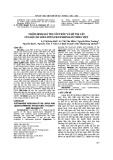
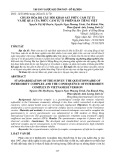

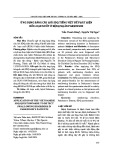
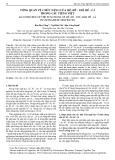
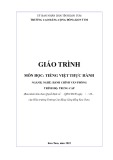
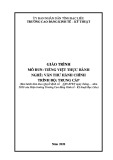

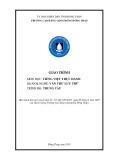
![Giáo trình Tiếng Việt thực hành - Đại học Sư phạm Hà Nội [Mới nhất]](https://cdn.tailieu.vn/images/document/thumbnail/2021/20210111/trinhthamhodang1217/135x160/1372327845.jpg)
![Bộ câu hỏi trắc nghiệm Văn bản tiếng Việt [chuẩn nhất]](https://cdn.tailieu.vn/images/document/thumbnail/2025/20251127/thuynhung051106@gmail.com/135x160/24021764296609.jpg)


![Bài giảng Ngôn ngữ học đối chiếu Nguyễn Ngọc Chinh [PDF]](https://cdn.tailieu.vn/images/document/thumbnail/2025/20251101/vovu03/135x160/7471762139652.jpg)





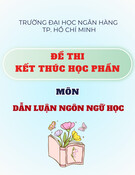

![Ngân hàng câu hỏi môn Tiếng Việt thực hành [chuẩn nhất]](https://cdn.tailieu.vn/images/document/thumbnail/2025/20251003/kimphuong1001/135x160/21861759464951.jpg)
![Bài giảng Văn học phương Tây và Mỹ Latinh [Tập hợp]](https://cdn.tailieu.vn/images/document/thumbnail/2025/20251003/kimphuong1001/135x160/31341759476045.jpg)


